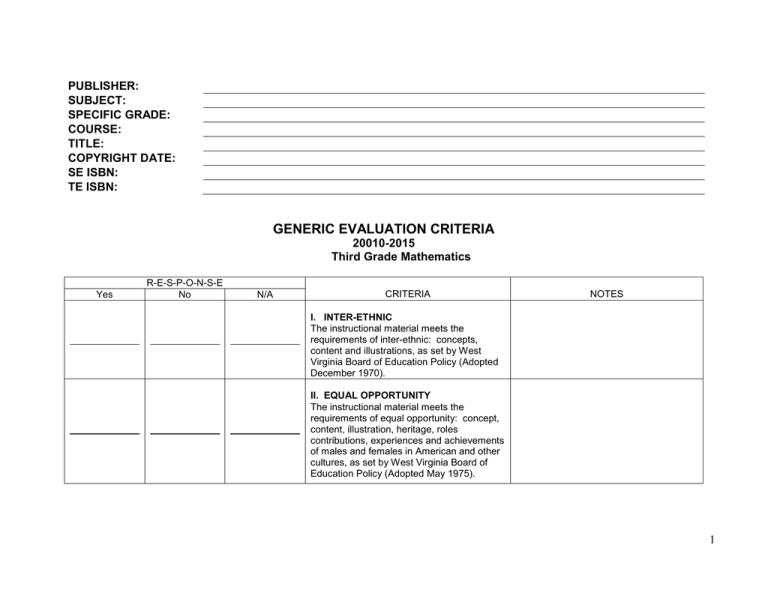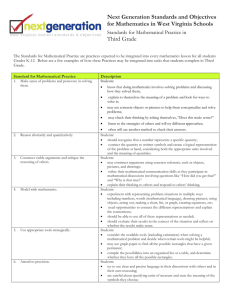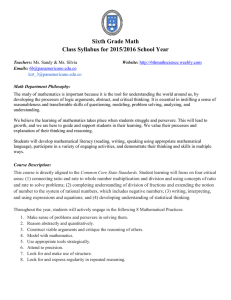GENERIC EVALUATION CRITERIA
advertisement

PUBLISHER: SUBJECT: SPECIFIC GRADE: COURSE: TITLE: COPYRIGHT DATE: SE ISBN: TE ISBN: GENERIC EVALUATION CRITERIA 20010-2015 Third Grade Mathematics Yes R-E-S-P-O-N-S-E No N/A CRITERIA NOTES I. INTER-ETHNIC The instructional material meets the requirements of inter-ethnic: concepts, content and illustrations, as set by West Virginia Board of Education Policy (Adopted December 1970). II. EQUAL OPPORTUNITY The instructional material meets the requirements of equal opportunity: concept, content, illustration, heritage, roles contributions, experiences and achievements of males and females in American and other cultures, as set by West Virginia Board of Education Policy (Adopted May 1975). 1 INSTRUCTIONAL MATERIALS ADOPTION: 21st CENTURY LEARNING EVALUATION CRITERIA GENERAL EVALUATION CRITERIA 20010-2015 Third Grade Mathematics (Vendor/Publisher) SPECIFIC LOCATION OF CONTENT WITHIN PRODUCT (IMR Committee) Responses I=In-depth A=Adequate M=Minimal N=Nonexistent I A M N In addition to alignment of Content Standards and Objectives (CSOs), materials must also clearly connect to Learning for the 21st Century which includes opportunities for students to develop A. Learning Skills Thinking and Problem-Solving Skills/ Rigor and Depth of Content Content is presented in a way that deepens student understanding through engagement in meaningful, challenging mathematics that builds on prior knowledge and promotes connections among mathematical concepts. Thinking and Problem-Solving Skills /Development of Conceptual Understanding Learning opportunities require students to develop their own viable mathematical understandings and help them build connections between mathematical ideas. Information and Communication Skills/Mathematical Language Appropriately introduce and reinforce in multiple ways all necessary terms and symbols. Personal and Work Place Productivity Skills 2 B. 21st Century Tools Problem-solving tools (such as spreadsheets, decision support, design tools) Communication, information processing and research tools (such as word processing, e-mail, groupware, presentation, Web development, Internet search tools) Personal development and productivity tools (such as e-learning, time management/calendar, collaboration tools) 3 INSTRUCTIONAL MATERIALS ADOPTION: 21st Century Learning EVALUATION CRITERIA The general evaluation criteria apply to each grade level and are to be evaluated for each grade level unless otherwise specified. These criteria consist of information critical to the development of all grade levels. In reading the general evaluation criteria and subsequent specific grade level criteria, e.g. means “examples of” and i.e. means that “each of” those items must be addressed. Eighty percent of the combined general and specific criteria must be met with I (In-depth) or A (Adequate) in order to be recommended. 20010-2015 Third Grade Mathematics (Vendor/Publisher) SPECIFIC LOCATION OF CONTENT WITHIN PRODUCT (IMR Committee) Responses I=In-depth A=Adequate M=Minimal N=Nonexistent I A M N For student mastery of content standards and objectives, the instructional materials will provide students with the opportunity to 4. Multimedia 1. offer appropriate multimedia (e.g., software, audio, visual, internet access) materials. 2. provide a website which provides links to relevant sites as well as lesson plans, student activities and parent resources. 4 3. Integrate technology seamlessly when appropriate to model mathematical situations, analyze data, calculate results, and solve problems. B. Scientifically-Based Research Strategies 1. Consistently require students to link prior knowledge to new information to construct their own viable understandings of mathematical ideas. 2. Consistently provide opportunities for students to solve complex problems that have multiple entry points and the possibility of multiple solution processes. 3. Consistently provide opportunities for students to communicate their mathematical thinking processes to others orally, in writing, or pictorially. 4. Routinely require students to develop and defend mathematical conjectures, arguments, reasoning and proof. 5. Provide opportunities for the students to be involved in investigations that enable them to make connections among mathematical ideas. 6. Expect students to develop multiple representations of the mathematics in order to depict reasoning used to explain real world phenomena or solutions to relevant problems and move fluently between those representations. 7. Present varied teaching models with emphasis on differentiated instruction in content, process, and product. 5 C. Critical Thinking 1. emphasize questioning models to promote higher order thinking skills based on depth of knowledge. 2. Consistently require students to discuss mathematics with each other and with the teacher, make arguments, conjecture and reason, and justify/clarify their ideas in writing and orally in precise mathematical symbols and language. 3. Present real world application that is current, engaging, integrated throughout the instruction, and promotes and develops critical thinking. D. Life Skills 1. address life skills (e.g., reading road maps, using reference tools, researching, reading a newspaper, using want ads, completing an application, applying the interview process and goal setting). 2. address habits of mind activities (e.g., literacy skills, interpersonal communications, problem solving and self-directional skills). E. Classroom Management 1. include opportunities for large group, small group, and independent learning. 2. Consistently require students to explore mathematical ideas, individually and collaboratively, while integrating the process standards (see Section I of this rubric). 3. provide suggestions for differentiated instruction (e.g., practice activities, learning stations, assessment, lesson plans). 6 F. Instructional Materials 1. Are organized according to WV content standards or other increments that allow students to investigate and explore major mathematical ideas; provide a variety of lessons, activities, and projects from which to choose; and emphasize connections between mathematical ideas. 2. Consistently integrate tasks that engage students and invite them to speculate and hypothesize, are open-ended, and require them to determine appropriate strategies. 3. Provide teachers with guiding questions to aid students’ development of mathematical discourse to further mathematical understanding. 4. Provide additional resources that are organized in a way that is easy to access and use. 5. Include various instructional models to address varied learning styles of students. 6. Provide extensive and varied opportunities to differentiate individual needs for skill-building. 7. Provide supplemental materials for intervention and enrichment. 8. Provide teachers with support to properly integrate the process standards using the available resources. 9. Include a teacher resource that builds content knowledge for the teacher. 10. Spiral previously taught skills and strategies with new content. 7 G. Assessment 1. provide assessment formats commensurate with WV assessment programs (e.g., WESTEST, NAEP, State Writing Assessment, informal assessments, PLAN, EXPLORE, ACT and SAT). 2. provide opportunities for assessment based on performance-based measures, open-ended questioning, portfolio evaluation, rubrics and multimedia simulations. 3. provide benchmark and ongoing progress monitoring. 4. provide rubric-based differentiated assessment. 5. provide an electronic system for managing assessment data to facilitate the implementation of tiered instruction 6. integrate student self-assessment for and of learning by providing tools and organizers that are linked to clearly identified learning goals. 7. Integrate formal and informal means of assessment in the materials for diagnostic, formative, and summative purposes. 8. include various types of assessments: performance tasks, multiple choice, short answer, and free response. 8 H. Process Standards 1. Problem Solving: Provide frequent opportunities for students to formulate, grapple with, and solve complex problems that require a significant amount of effort and have multiple viable solution paths. 2. Communication: Routinely challenge students to communicate their thinking to others orally, in writing, and/or pictorially, using precise mathematical language. 3. Reasoning and Proof: Provide frequent opportunities for students to complete mathematical investigations with and without technology; develop conjectures, mathematical arguments and proofs to confirm those conjectures. 4. Connections with Mathematics: Consistently establish connections, and provide opportunities for students to establish connections, among mathematical concepts and their real-world applications. 5. Representations: Provide frequent opportunities for students to develop multiple representations of the mathematics in order to depict reasoning used to explain real world phenomena or solutions to relevant problems and move fluently between those representations. 9 SPECIFIC EVALUATION CRITERIA Third Grade Mathematics Third grade objectives extend the students’ mathematical skills and concepts through concrete experiences and appropriate technology. These concepts and operations include: whole number operations; comparing and ordering numbers to hundredths and ten thousands; fractions and decimals; recall of multiplication facts with corresponding division facts. Additional concepts include gathering and organizing data, estimating and performing measurements. The West Virginia Standards for 21st Century Learning include the following components: 21st Century Content Standards and Objectives and 21st Century Learning Skills and Technology Tools. All West Virginia teachers are responsible for classroom instruction that integrates learning skills, technology tools and content standards and objectives. Standard 1: Number and Operations Through communication, representation, reasoning and proof, problem solving, and making connections within and beyond the field of mathematics, students will demonstrate understanding of numbers, ways of representing numbers, and relationships among numbers and number systems, demonstrate meanings of operations and how they relate to one another, and compute fluently and make reasonable estimates. Standard 2: Algebra Through communication, representation, reasoning and proof, problem solving, and making connections within and beyond the field of mathematics, students will demonstrate understanding of patterns, relations and functions, represent and analyze mathematical situations and structures using algebraic symbols, use mathematical models to represent and understand quantitative relationships, and analyze change in various contexts. 10 Standard 3: Geometry Through communication, representation, reasoning and proof, problem solving, and making connections within and beyond the field of mathematics, students will analyze characteristics and properties of two- and three-dimensional geometric shapes and develop mathematical arguments about geometric relationships, specify locations and describe spatial relationships using coordinate geometry and other representational systems, apply transformations and use symmetry to analyze mathematical situations, and solve problems using visualization, spatial reasoning, and geometric modeling. Standard 4: Measurement Through communication, representation, reasoning and proof, problem solving, and making connections within and beyond the field of mathematics, students will demonstrate understanding of measurable attributes of objects and the units, systems, and processes of measurement, and apply appropriate techniques, tools and formulas to determine measurements. Standard 5: Data Analysis and Probability Through communication, representation, reasoning and proof, problem solving, and making connections within and beyond the field of mathematics, students will formulate questions that can be addressed with data and collect, organize, and display relevant data to answer them, select and use appropriate statistical methods to analyze data, develop and evaluate inferences and predictions that are based on models, and apply and demonstrate an understanding of basic concepts of probability. 11 (Vendor/Publisher) SPECIFIC LOCATION OF CONTENT WITHIN PRODUCT (IMR Committee) Responses I=In-depth A=Adequate M=Minimal N=Nonexistent I A M N For student mastery of content standards and objectives, the instructional materials will provide students with the opportunity to A. Number and Operations 1. read and write numbers to 10,000. 2. order and compare numbers to 10,000 using a variety of strategies (e.g., symbols, manipulatives, number line). 3. read and write decimals to hundredths, with manipulatives. 4. order, and compare decimals to hundredths, with manipulatives. 5. identify place value of each digit utilizing standard and expanded form to 10,000. 6. apply estimation skills (rounding, benchmarks, compatible numbers) to solve and evaluate reasonableness of an answer. 12 7. demonstrate an understanding of fractions as part of a whole/one and as part of a set/group using models and pictorial representations. 8. create concrete models and pictorial representations to compare and order fractions with like and unlike denominators. 9. create concrete models and pictorial representations to add and subtract fractions with like denominators, and verify results. 10. use concrete models and pictorial representations to demonstrate an understanding of equivalent fractions. 11. use concrete models and pictorial representations to demonstrate an understanding of proper and improper fractions and mixed numbers. 12. add 2- and 3-digit whole numbers and money with and without regrouping. 13. subtract 2- and 3-digit whole numbers and money with and without regrouping. 14. demonstrate and model multiplication (repeated addition, arrays). 15. demonstrate and model division (repeated subtraction, partitioning). 13 16. use and explain the operations of multiplication and division including the properties (e.g., identity element of multiplication, commutative property, property of zero, associative property, inverse operations). 17. recall basic multiplication facts and the corresponding division facts. 18. model the distributive property in multiplication of 2- and 3-digit numbers by a 1-digit number. 19. use models to demonstrate division of 2- and 3-digit numbers by a 1-digit number. 20. create grade-appropriate real-world problems involving any of the four operations using multiple strategies, explain the reasoning used, and justify the procedures selected when presenting solutions. B. Algebra 1. analyze and extend geometric patterns. 2. analyze and extend numeric patterns. 3. create an input/output model using addition, subtraction, multiplication or division. 4. analyze a given pattern and write the rule. 14 5. write equivalent numerical expressions and justify equivalency. 6. use symbol and letter variables to represent an unknown quantity and determine the value of the variable. C. Geometry 1. identify and create new polygons by transforming polygons. 2. identify and create new polygons by combining and decomposing polygons. 3. identify, describe, and classify the following geometric solids according to the number of faces, edges, and vertices: cube rectangular solid cylinder cone pyramid 4. identify a solid figure from a plane drawing. 5. construct a solid figure from a plane drawing. 6. identify, describe and draw lines of symmetry in twodimensional shapes. 15 7. model, describe, and draw lines and rays. 8. model, describe, and draw angles including right, obtuse, and acute angles. 9. draw an example of a flip, slide and turn (reflection, translation, and rotation) given a model. 10. name the location of a point on a first-quadrant grid, represent using ordered pairs. D. Measurement 1. Within a project based investigation, identify a real life situation, consider a number of variables and use appropriate measurement tools, overtime, make a hypothesis as to the change over time; with more precision than whole units; length in centimeters and inches, temperature in Celsius and Fahrenheit weight/mass in pounds and kilograms, and design and implement a method to collect, organize, and analyze data; analyze results to make a conclusion; evaluate the validity of the hypothesis based upon collected data; design a mode of presentation (with and without technology). 2. estimate and find the perimeter and area of familiar geometric shapes, using manipulatives, grids, or appropriate measuring tools. 16 3. determine the formula for the area of a rectangle and explain reasoning through modeling. 4. read time to 5-minute intervals (am and pm) using analog and digital clocks. 5. compute elapsed time to the quarter-hour using a clock. 6. identify, count and organize coins and bills to display a variety of price values from real-life examples with a total value of $100 or less. 7. model making change using manipulatives. E. Data Analysis and Probability 1. collect and organize grade-appropriate real-world data from observation, surveys, and experiments, and identify and construct appropriate ways to display data. 2. develop and conduct grade-appropriate experiments using concrete objects (e.g. counters, number cubes, spinners) to determine the likeliness of events and list all outcomes. 3. analyze real-world data represented on a graph using grade-appropriate questions. 17








